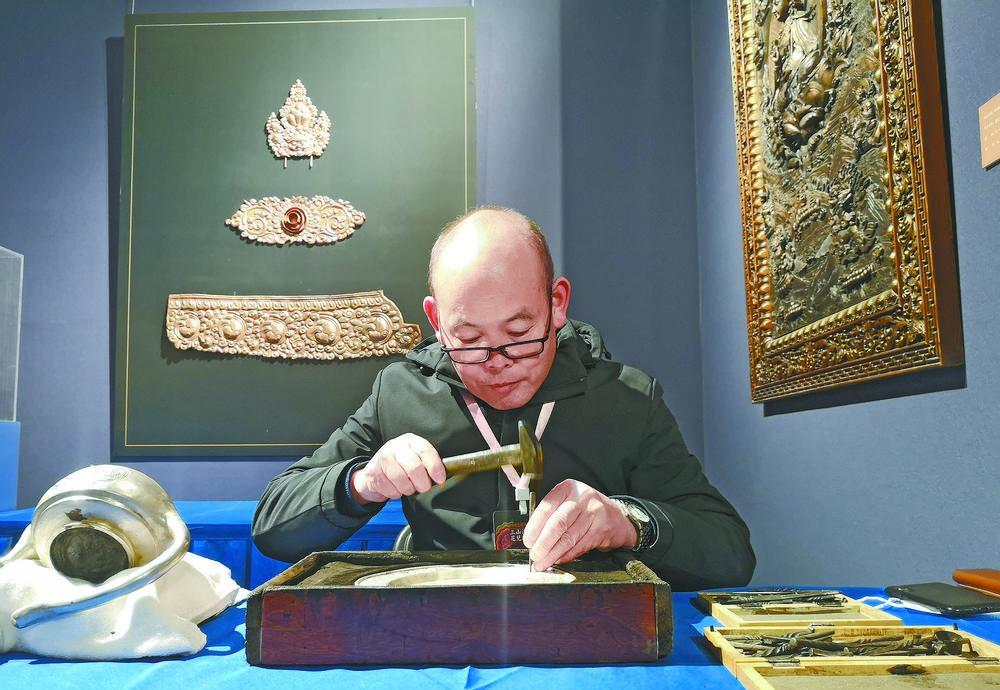
He Man, a national inheritor of silver and bronze making and gilding skills, is making silver and bronze ware. Photo by Wang Tianjiao
□ Li Shaotang
Huangzhong silver bronze ware making and gilding technology has a long history. According to records, in the twenty-fourth year of Qing Daoguang (1844), Wang Zhen, an artist from Linxia, Gansu, moved to Lushar, where he made casting copper and took his son Wang Shouli and five others as apprentices. By the end of the Qing Dynasty and the beginning of the People's Republic, the processing of Huangzhong silver bronze began to take shape. At present, in addition to a street of Thar Monastery Dongla Road, there are also many silver and bronze workshops in Angzang, Yinpo, Yangpo, Nanmen Village and Xibao Town Xihuayuan Village in Lushar Town, and there are more than 2,000 farmers engaged in silver and bronze processing, with an annual income of more than seven million yuan, and in addition to local sales, some of the products are exported to Nepal and domestic Gansu, Inner Mongolia, Guangdong, Yunnan, Sichuan and other provinces and regions.
A giant earthen pot made by Huangzhong Silver Bronze Craftsmen was exhibited at the Gongwangfu Museum of the Ministry of Culture and Tourism and received great attention from the audience in the capital. The extra-large copper clay pot with a height of 280 centimeters, a diameter of 201.9 centimeters, and eight dragons coiled on the lid of the pot was surrounded by many visitors. This earthen pot was carefully built by 72 Huangzhong craftsmen who spent more than 2,000 days and nights. In the manufacturing process, more than ten kinds of traditional handicraft techniques such as hammering, engraving, gilding, wrong silver, inlay, filigree, roasted blue, hanging tin, folding, welding, polishing are used, etc., inlaid with traditional patterns such as auspicious eight treasures and ruyi lotus, and also integrate modern patterns such as social harmony and mountain and river splendid embroidery. With a volume of about 2.2 cubic meters, the pot is divided into 4 cooking spaces and can cook 2 cows, 8 sheep and 100 chickens at the same time.
Huangzhong bronze processing processing pattern is complex, the shape is realistic, and the expression technique is outstanding. Artists often paint eight treasures such as umbrellas, goldfish, treasure vases and other eight treasures and mandalas, golden-winged birds, dragons, phoenixes, lions, auspicious clouds, treasure flames and other patterns, with a wide variety. Daily utensils include teapots, tea lids, saucers, hot pots, wine utensils, chopsticks, ear scoops, toothpicks, wine pots, wine cups, wine plates, pots, bowls, lamps, spoons, incense burners, fire pots, braziers, wax tables, hand stoves, braids, earrings, necklaces, bracelets, etc.
The processing technology of Huangzhong silverware is known for its thin shape, brightness, gentleness, purity and exquisiteness. A piece of silverware production to go through the molten silver water, casting blanks, leaves out of strips of wire drawing, statues, gilding, polishing and polishing, but also through the gilding process of gold, plastering, gold, calendering, thousands of hammers and hammers, in order to produce a piece of ingenious silverware, the ingenuity contained in it is impressive.
Qinghai Daily (April 1, 2022, 7th Edition: Society)